Technology
The best iPhones in 2024: Which iPhone is right for you?
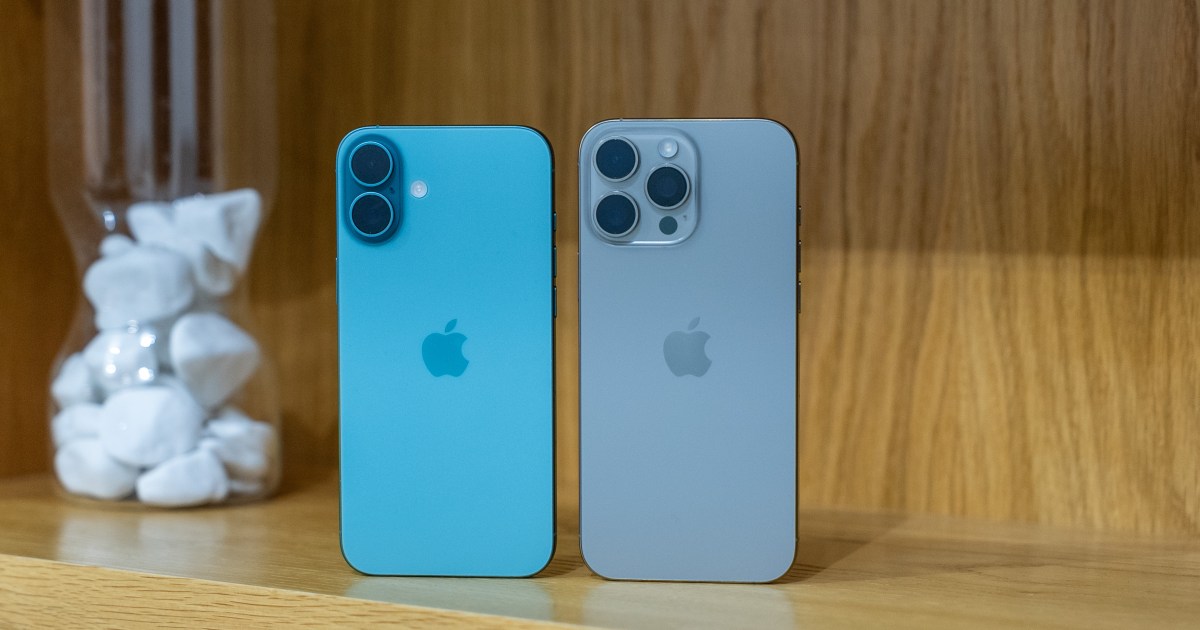

Nirave Gondhia / Digital Trends
Imagine having an AI assistant on your phone that can analyze documents, write emails, and even generate creative content. That future is closer than you think with Apple Intelligence, and the new iPhones are leading the way.
While the latest iPhones offer cutting-edge technology, older models like the iPhone 15 remain excellent. They provide a similar experience at a lower cost; some even come in unique colors that are no longer available on newer models.
Ready to explore the world of iPhones? We’ve got you covered. Our top pick for most people is the iPhone 16, but we’ll help you find the perfect fit, whether you’re looking for the best value, the most advanced features, or even considering switching to Android.
Here’s our list of the best iPhones of the year.

Joe Maring / Digital Trends
iPhone 16
The best iPhone for most people
Pros
- Fun, refreshing new design
- Stunning colors this year
- Camera Control is so, so good
- The Action button rules
- Excellent camera system
- Reliable battery life
Cons
- 60Hz display, no always-on display
- Slow charging speeds
- Apple Intelligence not yet available
Why you should buy this: It’s truly the best iPhone for most folks. Plus, it comes in some truly incredible colors.
Who it’s for: Anyone who wants a new iPhone, but doesn’t necessarily need all the camera tricks the iPhone 16 Pro series offers.
Apple has outdone itself with the iPhone 16. It would be easy to dismiss the base model as the “budget” option, overshadowed by its more expensive and feature-rich Pro siblings. However, the iPhone 16 breaks the mold, delivering a delightful and surprisingly complete smartphone experience that punches well above its weight class.
This year, the gap between the standard and Pro models feels significantly narrower. The iPhone 16 boasts a refreshed design that’s both modern and comfortable to hold. Performance is incredibly smooth thanks to the powerful A17 Bionic chip, which easily handles demanding apps and games. While lacking the telephoto lens of the Pro models, the camera system still captures stunning photos and videos with improved low-light capabilities and impressive image stabilization.
However, what truly sets the iPhone 16 apart are the thoughtful additions that elevate the user experience. The Action button, customizable for various tasks and shortcuts, adds a new layer of convenience and personalization. Camera Control offers quick access to camera settings, making it easier to capture the perfect shot. And with the latest iOS software, the iPhone 16 enjoys a seamless and intuitive user experience.
Of course, every phone is flawed. The iPhone 16 does have a 60Hz display, missing out on the smoother 120Hz ProMotion technology found in the Pro models. It also lacks an always-on display. However, these are minor compromises in the grand scheme of things, especially considering the significant price difference.
Ultimately, the iPhone 16 is a testament to Apple’s ability to deliver exceptional value without sacrificing the core elements that make iPhones so appealing. It’s a phone that excels in everyday use, offering a fantastic blend of design, performance, features, and user experience. For most users, the iPhone 16 is not just a good choice; it’s arguably the best iPhone this year.

iPhone 16
The best iPhone for most people

Joe Maring / Digital Trends
iPhone 16 Pro
The best small flagship iPhone
Pros
- Camera Control is a lovely addition
- Great display and performance
- 5x telephoto camera on a small iPhone
- The new Photographic Styles
- 4K 120fps video recording
Cons
- Disappointing battery life
- Apple Intelligence not yet available
- The regular iPhone 16 is SO good
Why you should buy this: It has everything you could want in an iPhone, just in a smaller package.
Who it’s for: You’re the type of person that wants the best phone Apple makes, with all the frills, but with a smaller display than the iPhone 16 Pro Max.
The iPhone Pro has always been an easy sell. For those seeking the best iPhone experience and willing to pay a premium, the Pro models have consistently delivered with their cutting-edge features and top-tier performance. But this year, the decision is more nuanced. Apple has raised the bar with the iPhone 16, making it the most compelling non-Pro iPhone in years. This presents a challenge for the iPhone 16 Pro, forcing it to justify its higher price tag against a surprisingly capable sibling.
Don’t get us wrong, the iPhone 16 Pro is a fantastic phone. It’s beautifully crafted, incredibly powerful, and boasts a camera system that captures stunning photos and videos. But the iPhone 16 has narrowed the gap significantly. Both phones share key features like the Action button, Camera Control, and the latest iOS 18 software. Performance is nearly identical thanks to the A17 Bionic chip, and in some cases, the iPhone 16 even surpasses the Pro in battery life. The iPhone 16 also has a lighter and more comfortable design, with a wider array of color options.
So, where does the iPhone 16 Pro truly shine? It comes down to two key areas: the display and the camera. The Pro’s 120Hz ProMotion display offers a buttery-smooth experience that’s noticeable in everyday use, from scrolling through web pages to playing graphics-intensive games. And for photography enthusiasts, the Pro’s telephoto lens and advanced camera features provide greater versatility and creative control.
Ultimately, the decision hinges on your priorities and budget. If you value the smoothest display and the most advanced camera system, the iPhone 16 Pro remains a worthy investment. But for most users, the iPhone 16 delivers an exceptional experience at a more affordable price. It’s the phone this writer chose for themself, and it’s the one we believe will satisfy the needs of most iPhone buyers.

iPhone 16 Pro
The best small flagship iPhone

Christine Romero-Chan / Digital Trends
iPhone 16 Pro Max
The best big iPhone
Pros
- Beautiful display
- Powerful performance
- Camera Control is a nice addition
- Great battery life
- Improved ultrawide camera
Cons
- It’s too darn big
- Boring colors
- Apple Intelligence not available yet
Why you should buy this: When money is no object and you want the biggest and most powerful iPhone today, this is the one to purchase.
Who it’s for: As usual, Apple’s latest iPhone Pro Max is the best iPhone ever created, in terms of features and materials. Therefore, if that’s what you want, here you go.
The iPhone 16 Pro Max is a compelling device, but it’s an optional upgrade for everyone. If you value a larger screen and prioritize camera quality, the Pro Max delivers with its superior telephoto and upgraded 48MP ultrawide lens. This is especially true if you’re using an older iPhone and are looking for a significant leap in camera technology. However, iPhone 15 Pro Max users may want to hold off, as the iOS 18.1 update with Apple Intelligence bridges the gap in AI capabilities.
The impressive feature set of the base iPhone 16 models makes the upgrade decision even more complex. Both the iPhone 16 and 16 Plus boast notable additions like the Action button, Camera Control, an improved ultrawide lens, new Photographic Styles, the powerful A18 chip, extended battery life, and a more diverse color palette. This makes the standard iPhone 16 a compelling option for those seeking a balance of features and affordability.
Ultimately, the iPhone 16 Pro Max caters to users with specific needs. Its key advantages lie in the telephoto lens, the always-on display with a 120Hz refresh rate, and advanced photography and videography features. If these are essential to your workflow or lifestyle, the iPhone 16 Pro Max will undoubtedly meet your expectations. However, if your priorities differ, exploring the iPhone 16 or waiting for Apple Intelligence on the iPhone 15 Pro Max might be equally viable options.

iPhone 16 Pro Max
The best big iPhone

Andy Boxall / Digital Trends
iPhone 16 Plus
The best big iPhone runner-up
Pros
- Fantastic hardware and colors
- Big, bright screen
- Fast, reliable, and feature-packed software
- Fun camera and Camera Control
- Long battery life
Cons
- Only a 60Hz refresh rate
- No always-on screen
Why you should buy this: It has everything the highly-rated iPhone 16 has but with a larger display.
Who it’s for: Anyone who wants our favorite iPhone of the year, but wants it with a larger display.
The iPhone 16 Plus presents a curious dilemma. While it is undeniably an excellent phone, its place in the iPhone lineup feels ambiguous. An iPhone 16 with a larger display needs help distinguishing itself and definitively justifying its higher price tag.
The core issue lies in the compromises it entails. Its size and weight might be cumbersome for some, while the 60Hz display feels outdated in 2024, especially when competitors offer higher refresh rates for smoother visuals. Furthermore, the anticipated battery life gains over the standard iPhone 16 seem negligible. This begs the question: why not opt for the more affordable iPhone 16, which offers a nearly identical experience in a more manageable form factor?
Conversely, those seeking a premium large-screen experience might find the iPhone 16 Pro Max more compelling. It boasts an even larger display with ProMotion technology for a 120Hz refresh rate and other advantages like a telephoto lens and enhanced camera capabilities.
Ultimately, the iPhone 16 Plus occupies a precarious middle ground. It excels in providing a big-screen experience without the “Pro” price but lacks a standout feature to solidify its appeal. Unless a more prominent display is your priority, the iPhone 16 or 16 Pro Max offers more compelling value propositions. The iPhone 16 Plus, while a capable device, risks being overshadowed by its siblings due to its lack of a defining characteristic.

iPhone 16 Plus
The best big iPhone runner-up
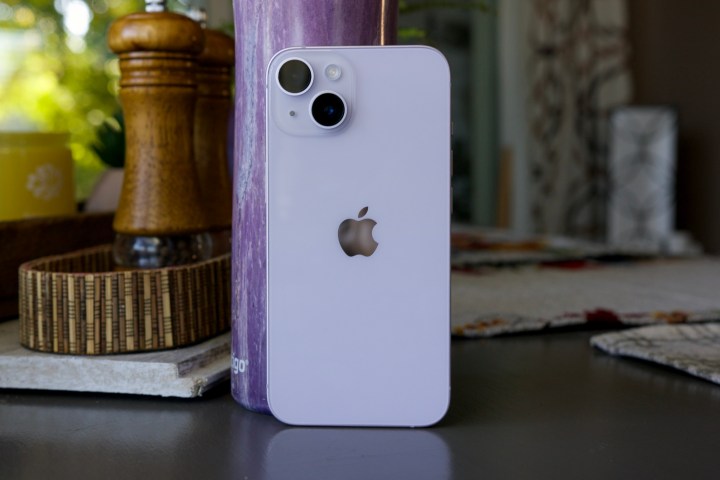
Joe Maring / Digital Trends
iPhone 14
The best value iPhone
Pros
- Comfortable, high-end build
- OLED screen looks fantastic
- A15 chip performs great
- Good camera upgrades
- Dependable battery life
- Helpful safety features
Cons
- 60Hz display
- No telephoto camera
- eSIM might be a pain for some
Why you should buy this: You want a solid iPhone without having to pay too much.
Who it’s for: Those who want to get some good bang for their buck.
The iPhone 14, while not the most groundbreaking device for tech enthusiasts, remains a compelling option for those upgrading from an older iPhone. Despite being two years old, it offers a robust and refined smartphone experience.
One of its key strengths lies in its processor. Though not the latest model, the A15 Bionic chip, inherited from the iPhone 13 Pro, delivers impressive performance for everyday tasks and even demanding applications. Users transitioning from pre-iPhone 13 models will experience a significant boost in speed and responsiveness.
While it lacks the flashy features of its successors, such as the 48MP camera, Dynamic Island, and always-on display, the iPhone 14 still boasts a capable camera system that captures excellent photos and videos. Furthermore, it incorporates crucial safety features like Emergency SOS via satellite and crash detection, providing valuable peace of mind.
Essentially, the iPhone 14 represents a compelling blend of performance, reliability, and affordability. It’s an ideal choice for users seeking a significant upgrade without the premium price tag of the latest models. If you prioritize a smooth user experience, a dependable camera, and essential safety features, the iPhone 14 is a worthy contender.
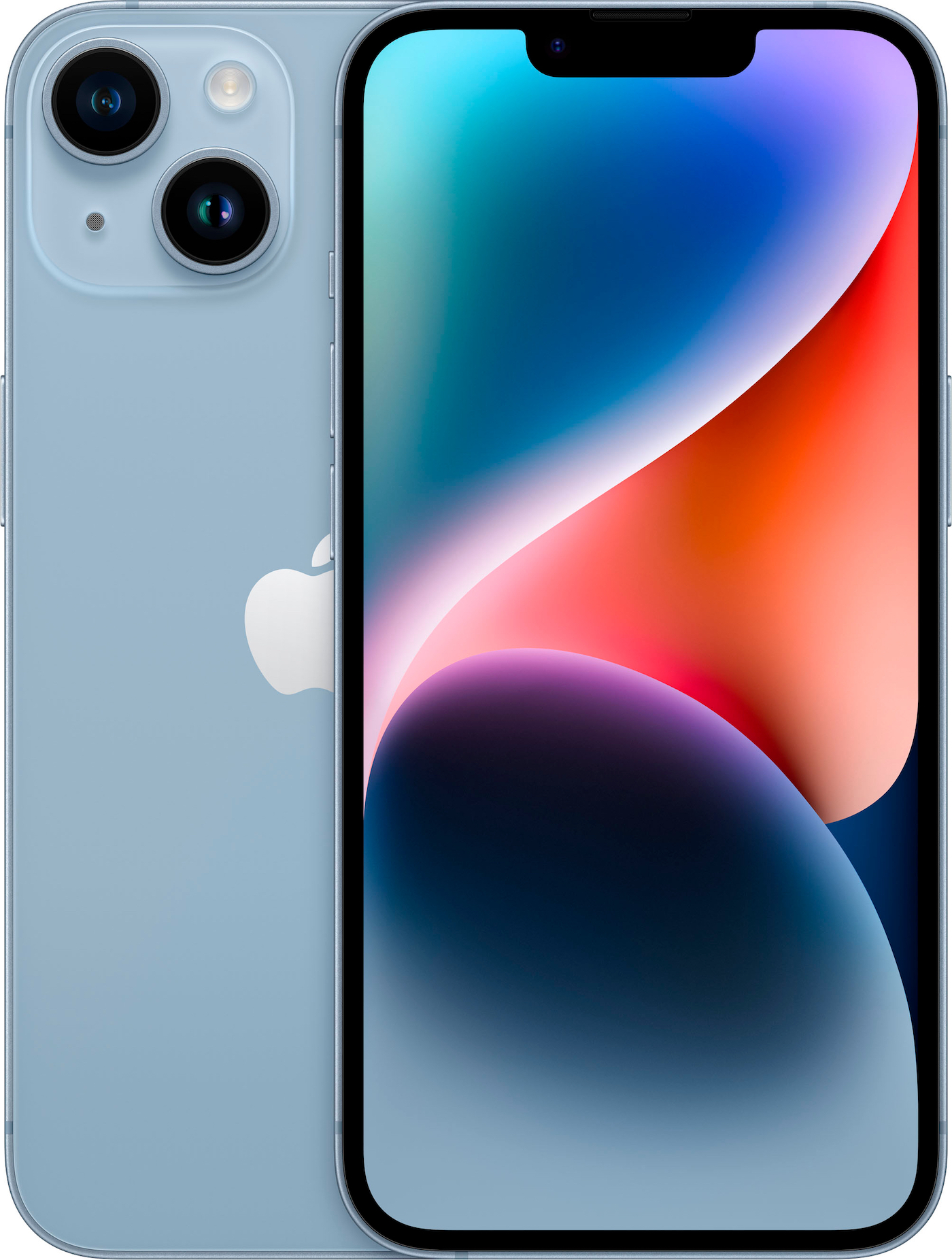
iPhone 14
The best value iPhone
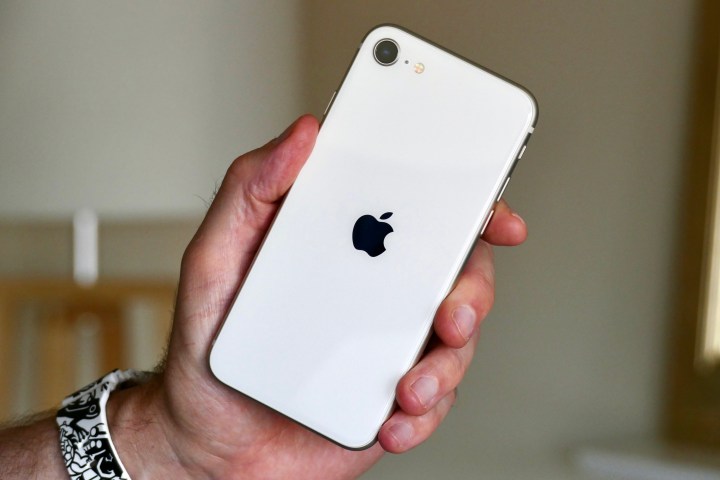
Andy Boxall / Digital Trends
iPhone SE (2022)
The best small iPhone
Pros
- Compact and light
- Very powerful
- Touch ID works really well
- Wireless charging
- IP67 water resistance
Cons
- Poor battery life
- 60Hz screen
- 64GB won’t be enough
Why you should buy this: If you are looking for an iPhone that is smaller than 6.1-inches, then this is the one to get. It also has some pretty decent features.
Who it’s for: You want the most compact iPhone there is.
The iPhone SE (2022) still presents a compelling proposition for budget-conscious consumers seeking a powerful and compact iPhone experience. Starting at $429, it’s the most affordable new iPhone available, offering exceptional value for its price.
While its design, inherited from the iPhone 8, might appear dated, it retains a sturdy build with the same durable glass used in the iPhone 13. Its compact size makes it ideal for one-handed use and appeals to those who prefer smaller phones.
Under the hood, the iPhone SE (2022) boasts the impressive A15 Bionic chip found in the iPhone 13 and 14, ensuring smooth performance and efficient multitasking. Coupled with 4GB of RAM and storage options ranging from 64GB to 256GB, it handles everyday tasks with ease. Compared to its predecessor, a larger battery provides ample power to last throughout the day.
The 4.7-inch Liquid Retina display, though small by modern standards, delivers sharp visuals with a resolution of 1334 x 750 pixels. Features like True Tone technology and wide color support enhance the viewing experience. The camera system, featuring a 12MP rear camera and a 7MP front camera, captures satisfactory photos in good lighting conditions, though it lacks Night mode for low-light photography. Touch ID provides reliable security, though Face ID is absent.
With 5G connectivity, the iPhone SE (2022) is a future-proof choice, offering faster download and upload speeds in areas with 5G coverage. However, it’s important to consider its limitations and future. The small screen might not be ideal for media consumption or gaming, and the lack of Night mode hinders low-light photography. Additionally, this model is expected to be replaced by a new one sometime in 2025.
The iPhone SE (2022) is a fantastic option for those prioritizing affordability, performance, and portability. It’s an excellent entry point into the Apple ecosystem or a reliable upgrade for users with older iPhones, as long as its compromises are considered.

iPhone SE (2022)
The best small iPhone
Technology
Samsung Electronics is in crisis, say employees
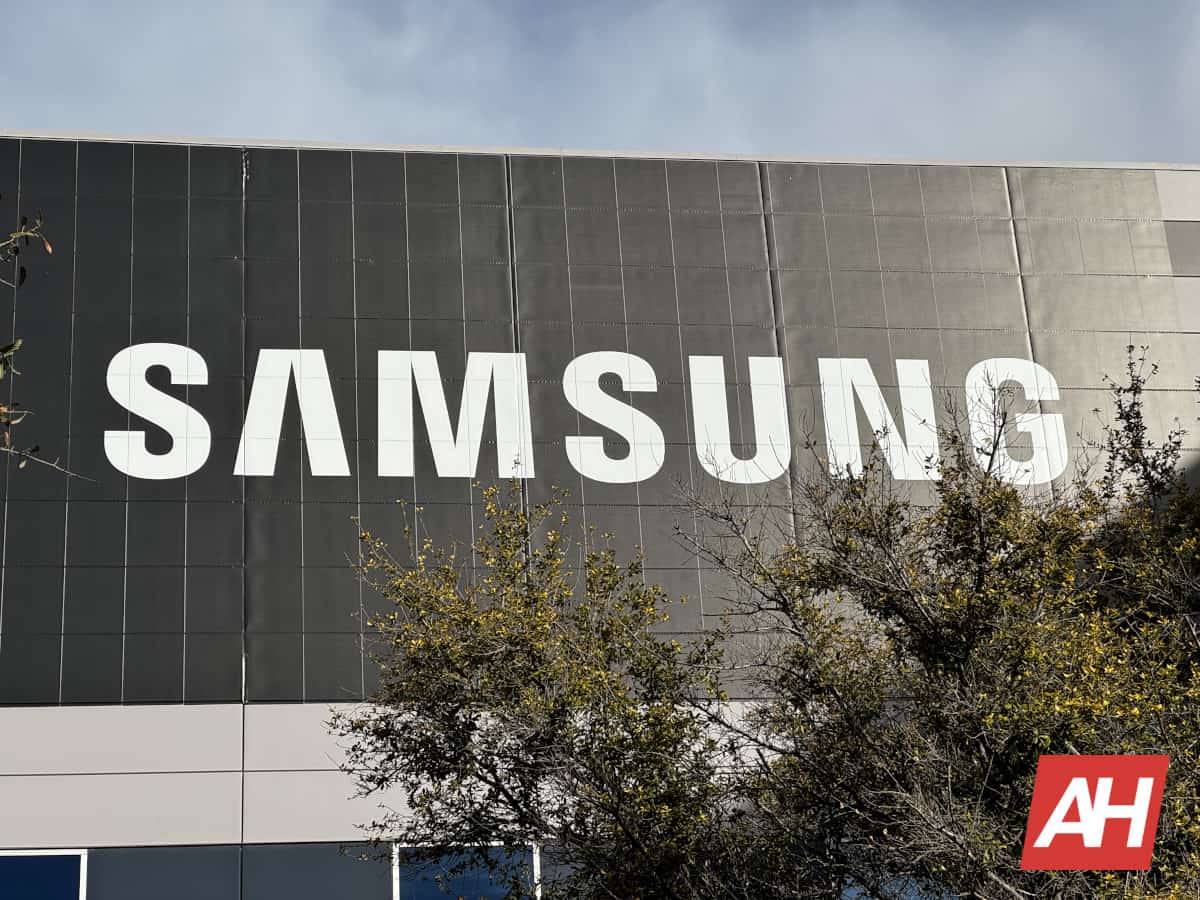
News continues to pour in about the delicate situation at Samsung Foundry, the company’s semiconductor production division. Things seemed to be improving following the good performance of the Exynos 2400 chip. However, recent developments revealed severe hurdles to overcome in order to get back on track. Interviews with Samsung employees indicate that the company is currently facing a “crisis.”
Samsung Foundry and its low yield rate issues
Samsung Foundry’s main problems stem from the low yield rate of its 3nm GAA wafers. The company had hoped to make the Eynos 2500 chip an attractive, powerful, and efficient SoC thanks to the new process. However, its factories have not been up to the task. Recent reports claim that only about 25–30 chips out of every 100 produced are usable. Meanwhile, at their worst, wafers have shown a yield rate of just 10%.
Samsung is reportedly trying to improve the yield rate of its 3nm GAA wafers before deciding which chip to use in the Galaxy S25 series. Given the severity of the situation, it is highly likely that Samsung will have to replace its Exynos 2500 chip with the more expensive (yet powerful) Snapdragon 8 Elite. However, the South Korean giant is keeping the faith and is still testing the Exynos 2500 in case they manage to turn things around at the last minute.
Samsung employees and former employees see a crisis in the company
Damnangyi, a YouTuber and former Samsung employee, shared a video with views from people related to the company. The opinions are about the current situation and the potential causes. First, seven former employees and 24 current employees claim that Samsung is in crisis. Most of them believe that Samsung’s current pace of innovation is slow. This would be a direct consequence of a lack of vision on the part of the board of directors. Some have even expressed concerns about the management’s treatment of employees.
Damnangyi currently works at Qualcomm in the US. However, his time at Samsung was enough to know what was going on internally. Plus, the situation is no secret, as representatives apologized to investors this month for the disappointing financial results and lack of innovation.
The company will seek to change the situation with more innovation
In its official apology, Samsung Electronics teased its strategy to try to turn things around. The company mentioned that it will bet more on innovation and on the development of long-term solutions. Only time will tell if Samsung manages to get back on track or if the internal crisis worsens. Recently, Samsung Mobile launched the Galaxy Z Fold Special Edition in an attempt to compete with the ultra-thin foldables of Chinese brands.
Technology
Huawei appears to still be using TSMC chips despite US sanctions

A Canadian research firm called TechInsights took a deep dive on one of Huawei’s artificial intelligence accelerators and found a chip manufactured by Taiwan Semiconductor Manufacturing Company (TSMC). Bloomberg spoke with several people familiar with the investigation who asked to remain anonymous since TechInsights’ report has been released to the public.
The anonymous sources says TechInsights’ investigation found an Ascend 910B chip made by TSMC in one of Huawei’s AI accelerators. The company that conducted the investigation declined to comment.
Reuters reports that TechInsights informed TSMC of its findings before publishing its report. This prompted TSMC to notify the US Commerce Department earlier this month. The Financial Times reports, citing people familiar with the matter, that TSMC told the department that a customer had placed orders for a chip similar to Huawei’s Ascend 910B. One of the FT‘s sources said that TSMC “had spoken both to the customer involved and to the commerce department” after recieving the suspicious order.
The US Commerce Department implemented additional trade restrictions against Huawei that barred the electronics company from obtaining chips made by foreign firms. Earlier this year, the US government tightened its restrictions even further by revoking its licenses with Intel and Qualcomm to produce chips for its devices.
TSMC denied that it had a working relationship with Huawei since mid-September of 2020 in a statement provided to the Commerce Department. TSMC also told Bloomberg that it hasn’t produced any chips for Huawei due to the amended restrictions. Huawei denied that it had ever “launched the 910B chip.”
This isn’t the first time Huawei has been caught trying to subvert US sanctions and trade restrictions. Bloomberg also uncovered in May that Huawei funded secret research in the US at universities including Harvard by funneling the money through a Washington-based scientific research foundation called Optica. The foundation said it decided to return the money in June and chief executive officers Elizabeth Rogen and Chad Stark stepped down the following August.
Update, October 22, 7:10PM ET: This story was updated after publish with more details from the Financial Times‘ reporting on the matter.
Technology
Netflix shutters its only triple-A studio, loses major industry hires
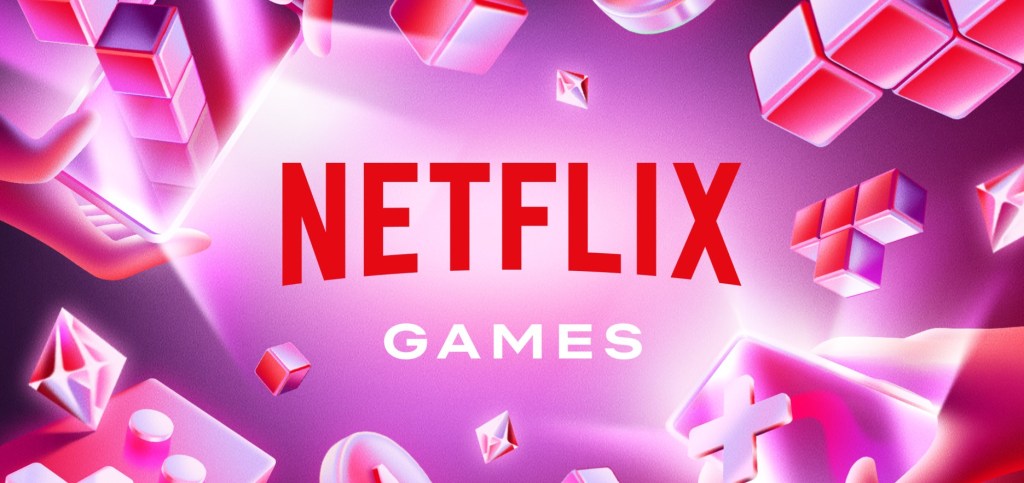
Netflix today closed one of its internal game studios, one which was poised to release a triple-A title, before it was able to produce anything. The studio was called Team Blue, founded in 2022 and based on Los Angeles, and was allegedly working on a PC game. As a result of this studio closure, the company has also lost the talent it very publicly hired, and has also reportedly made other layoffs in its games division.
Game File reported the closure, saying that Team Blue was working on a “big-budget multi-device strategy” at the time. To staff out this new studio, Netflix hired several recognizable names from major games companies — including studio lead Chacko Sonny, formerly Overwatch’s executive producer; creative director Joseph Staten, formerly creative lead on Halo; and art director Rafael Grassetti, formerly of Sony Santa Monica. According to the Game File report, all three have left the company with the closure of the LA studio.
Netflix has several internal studios where it’s building games for its platform. It acquired the likes of Night School, Boss Fight, Next Games and Spry Fox, and built two studios of its own — aside from Team Blue, it also has a studio in Helsinki. At present, those studios all appear to be intact, though a recent report from Business Insider suggests that Netflix has laid off several people within its games division.
The streaming company has also shifted its games strategy this year, as Mike Verdu, who spearheaded its games initiative, shifted to a new role. It also hired Alain Tascan as its president of games earlier this year. Shortly before Tascan’s hiring, Netflix’s VP of external games Leanne Loombe told the Washington Post that the company wanted to take a mobile-first approach to games launches, and mentioned that Netflix’s subscribers appear to favor short, “snackable” mobile games.
Source link
Technology
Artiphon’s new Orba instrument can sample sounds live
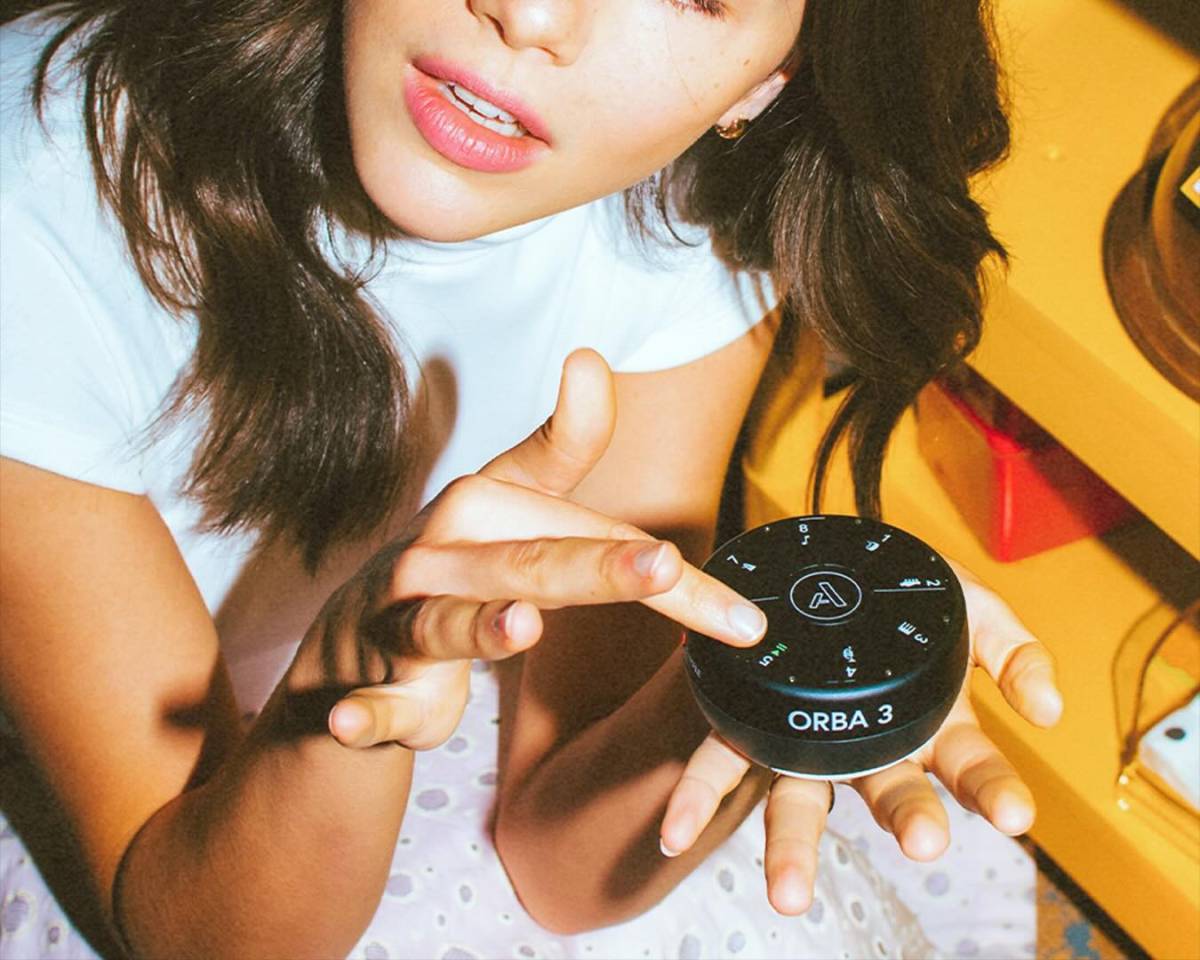
Almost exactly two years after releasing the Orba 2, Artiphon is completing the trilogy. The newly announced Orba 3 finds the Nashville-based startup baking live sampling into its clever handheld instrument. The feature arrives by way of a built-in microphone, which lets users record their voice, instruments, and other sounds.
All of that can be accomplished on-device, meaning there’s no need for an external system to load sounds onto the instrument. Instead, you click the big, red Sample button on the side, record a sound, and that’s pretty much it.
Switching the Orba into one of the four different modes — bass, chord, drum, lead — assigns different properties to the sound. It’s a clever addition to what was already an extremely fun little gadget.
“In Drum mode, each pad can hold a unique sample, while in Chord mode, samples are automatically tuned to fit musical chords,” the company explains. “This is made possible by a sophisticated sound engine that automatically crops, tunes, and perfects the audio.”

As with its predecessors, the Orba 3 can be used as a MIDI controller when connected to an external device via USB-C.
The instrument is available for $160 on Artiphon’s website. The Orba 2 is sticking around, meanwhile, now priced at $120. Artiphon announced the Chorda last year, which TechCrunch described as a mashup between Orba and the company’s first offering, Instrument 1.
Science & Environment
A ‘tidal wave’ of LNG supply will reshape global markets, says RBC Capital

Liquefied natural gas (LNG) storage units.
Dan Kitwood | Getty Images News | Getty Images
The biggest influx of liquified natural gas (LNG) supply is coming online and it will transform the global market, bringing about wide and enduring effects, said RBC Capital Markets.
“A wave of new LNG supply —the biggest yet— is set to reshape the global market in the coming years, with broader implications than prior growth given increasing inter-linkages between regional gas markets following the Russia-Ukraine conflict,” analysts from the investment bank wrote in a note.
The supply injection is likely to thrust the market into an extended period of oversupply by the end of 2026, which will remain until 2030, with prices possibly moving below double-digits, analysts such as RBC’s Anan Dhanani have projected.
Futures for the Dutch Title Transfer Facility (TTF) hub, a European benchmark for natural gas transactions, were trading at $12.78 per mmbtu on Wednesday on the New York Mercantile Exchange.
Throughout the year, a growing chorus of analysts have warned that tepid demand growth coupled with looming waves of export capacity could lead to a massively oversupplied market. As a stream of planned infrastructure continues to flood the market, it’s unclear if demand will increase to absorb each wave.
Oversupply and depressed prices underscore the bearish sentiments in the LNG sector, said Rystad Energy senior analyst Masanori Odaka. Suppliers are now increasingly prioritizing LNG used for shipping utilization over arbitrage opportunities, i.e. profit margins.
Commodity arbitrage involves the simultaneous or sequential buying and selling of commodities across different markets to profit from the price difference.
Global LNG trade has doubled in the last decade, growing from around 240 metric ton in 2014 to more than 400 metric ton last year, largely caused by the disruption of Russian pipeline gas to Europe, according to RBC Capital. Some had perceived the geopolitical risk as an opportunity in the market.
The investment bank projected that global liquefaction capacity, the total amount of LNG that can be produced annually, will grow by around 50% by the end of the decade. The U.S. and Qatar will hold onto their position as the world’s biggest suppliers, with a combined market share of almost 50% in 2030, RBC added.
Many private companies and state-owned entities have plans to boost capacity, “not only to backstop European consumption but to also capture an expected growth in consumption rates, particularly in Asia,” RBC’s analysts said.
But demand from the Asia-Pacific region, the biggest importer of LNG, is only expected grow by an average of 5% annually. Around 70% of this growth will stem from China, India and South Korea.
Meanwhile, LNG prices have not seen major fluctuations despite escalating geopolitical tensions. “Surprisingly quiet” was how Meg O’Neill, managing director and CEO of Woodside Energy, described the market.
“For me, maybe that’s a sign that there’s sufficient supply sources around the world to help mitigate any temporary supply disruption coming out of the Middle East. And that’s probably true for both oil and LNG,” O’Neill told CNBC on the sidelines of the annual Singapore International Energy Week conference.
There are other looming challenges to the LNG sector that could affect global markets. The 2024-25 Northern Hemisphere winter is in sight and existing contracts of Russian gas deliveries to Europe through Ukraine are set to expire at the end of 2024, the International Energy Agency pointed out.
“This could mean an end to all piped gas deliveries to Europe from Russia through Ukraine,” the IEA wrote in a recent note. “This in turn would require higher LNG imports into Europe next year, resulting in a tighter global gas balance.”
Technology
The Boox Palma 2 has a faster processor and adds a fingerprint reader
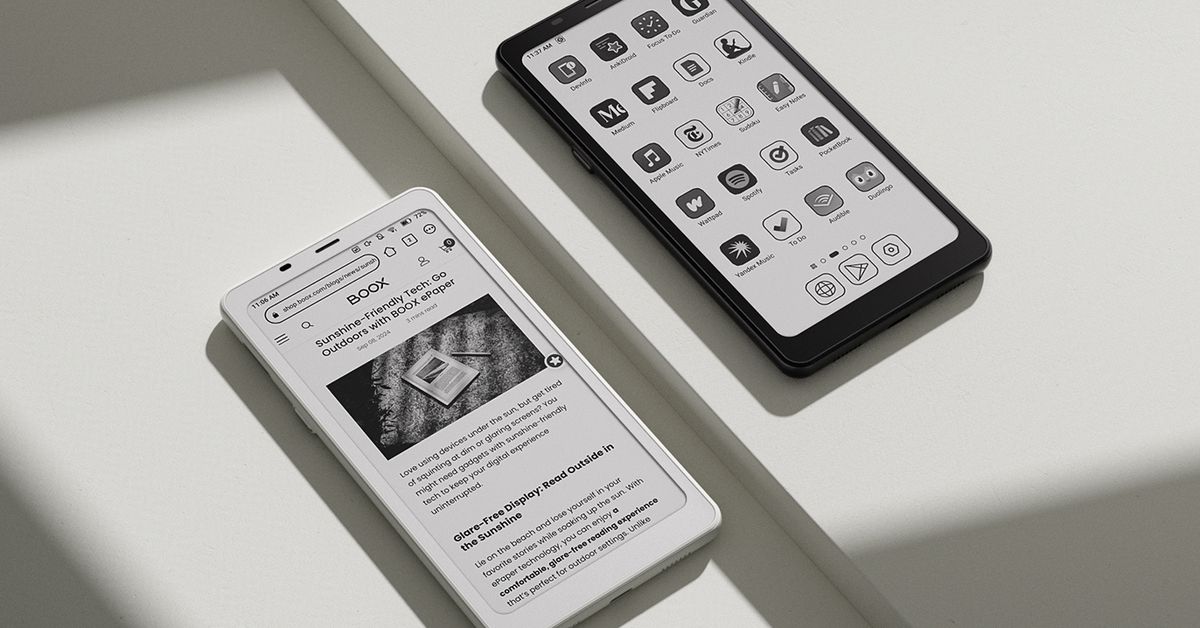
Boox has announced the Palma 2, the next version of its popular smartphone-sized e-reader. The Palma 2 addresses some of the original’s shortcomings, with a faster processor to address the original’s laggy interface and by running a newer version of Android.
But it was the Palma’s compact size and access to thousands of apps that helped it become a popular Kindle and Kobo alternative, and Boox isn’t messing with that formula for the Palma 2. It features the same 6.13-inch 300ppi E Ink Carta 1200 screen as the original (a generation behind what’s found in the latest Kindle Paperwhite) and once again comes with 6GB of RAM and 128GB of storage.
Although Boox hasn’t shared specific details, it says the new Palma 2 now runs a “faster octa-core CPU,” which will hopefully help speed up the new e-reader’s interface. It also runs Android 13 instead of Android 11. That’s still a few generations behind the latest version of Android, but it means the Palma 2 will get newer features like improved copying and pasting. It should also give the e-reader a few more years over the original before apps stop supporting its version of the OS.
The other notable upgrade for the Palma 2 is the addition of a fingerprint sensor integrated into its power button, making it easier to secure the device while still being able to quickly unlock it with just one hand.
Although leaked images from earlier this week suggested Boox could be eliminating cameras from its smartphone-sized e-readers, that was only the case for a version of the Palma limited to China. The Palma 2 has the same 16MP rear camera with flash as the original, which the company suggests is useful for digitizing documents.
Alongside the Palma 2, Boox also announced two new e-paper note-taking devices. The 10.3-inch Note Air4 C features the latest-gen Kaleido 3 color E Ink display with improved refresh rates and an octa-core processor that Boox says makes the tablet 50 percent faster than the previous model. The $499.99 Note Air4 C also runs Android 13 and has a new “tablet-like UI” that the company says makes it easier to customize its homescreen and organize apps.
The new Boox Note Max is a black-and-white, stylus-capable tablet featuring a larger 13.3-inch E Ink Carta 1300 display powered by a 2.8GHz octa-core CPU. At just 4.6 millimeters thick, the Note Max is almost half as thick as the Boox Palma 2. But unlike Boox’s other two devices introduced today, it won’t be available for preorder from the company’s online store for a few more weeks.
-

 Science & Environment1 month ago
Science & Environment1 month agoHyperelastic gel is one of the stretchiest materials known to science
-

 Technology4 weeks ago
Technology4 weeks agoIs sharing your smartphone PIN part of a healthy relationship?
-

 Science & Environment1 month ago
Science & Environment1 month ago‘Running of the bulls’ festival crowds move like charged particles
-

 Science & Environment1 month ago
Science & Environment1 month agoHow to unsnarl a tangle of threads, according to physics
-

 Science & Environment1 month ago
Science & Environment1 month agoMaxwell’s demon charges quantum batteries inside of a quantum computer
-

 Technology1 month ago
Technology1 month agoWould-be reality TV contestants ‘not looking real’
-

 Science & Environment4 weeks ago
Science & Environment4 weeks agoX-rays reveal half-billion-year-old insect ancestor
-

 Science & Environment1 month ago
Science & Environment1 month agoSunlight-trapping device can generate temperatures over 1000°C
-

 Science & Environment1 month ago
Science & Environment1 month agoLiquid crystals could improve quantum communication devices
-

 Science & Environment1 month ago
Science & Environment1 month agoQuantum ‘supersolid’ matter stirred using magnets
-

 Womens Workouts4 weeks ago
Womens Workouts4 weeks ago3 Day Full Body Women’s Dumbbell Only Workout
-

 Technology3 weeks ago
Technology3 weeks agoUkraine is using AI to manage the removal of Russian landmines
-

 TV3 weeks ago
TV3 weeks agoসারাদেশে দিনব্যাপী বৃষ্টির পূর্বাভাস; সমুদ্রবন্দরে ৩ নম্বর সংকেত | Weather Today | Jamuna TV
-

 Science & Environment1 month ago
Science & Environment1 month agoLaser helps turn an electron into a coil of mass and charge
-

 Science & Environment1 month ago
Science & Environment1 month agoWhy this is a golden age for life to thrive across the universe
-

 Science & Environment1 month ago
Science & Environment1 month agoQuantum forces used to automatically assemble tiny device
-

 Science & Environment1 month ago
Science & Environment1 month agoA new kind of experiment at the Large Hadron Collider could unravel quantum reality
-

 News2 weeks ago
News2 weeks agoNavigating the News Void: Opportunities for Revitalization
-

 Football3 weeks ago
Football3 weeks agoRangers & Celtic ready for first SWPL derby showdown
-

 News3 weeks ago
News3 weeks agoMassive blasts in Beirut after renewed Israeli air strikes
-

 Science & Environment1 month ago
Science & Environment1 month agoA slight curve helps rocks make the biggest splash
-

 Science & Environment1 month ago
Science & Environment1 month agoNerve fibres in the brain could generate quantum entanglement
-

 Science & Environment1 month ago
Science & Environment1 month agoHow to wrap your mind around the real multiverse
-

 News1 month ago
News1 month ago▶️ Hamas in the West Bank: Rising Support and Deadly Attacks You Might Not Know About
-
Business3 weeks ago
DoJ accuses Donald Trump of ‘private criminal effort’ to overturn 2020 election
-

 Business3 weeks ago
Business3 weeks agoWhen to tip and when not to tip
-

 MMA3 weeks ago
MMA3 weeks agoJulianna Peña trashes Raquel Pennington’s behavior as champ
-

 Science & Environment1 month ago
Science & Environment1 month agoITER: Is the world’s biggest fusion experiment dead after new delay to 2035?
-

 Science & Environment1 month ago
Science & Environment1 month agoNuclear fusion experiment overcomes two key operating hurdles
-

 Science & Environment1 month ago
Science & Environment1 month agoTime travel sci-fi novel is a rip-roaringly good thought experiment
-

 News1 month ago
News1 month ago▶️ Media Bias: How They Spin Attack on Hezbollah and Ignore the Reality
-

 Technology3 weeks ago
Technology3 weeks agoSamsung Passkeys will work with Samsung’s smart home devices
-

 News2 weeks ago
News2 weeks ago▶ Hamas Spent $1B on Tunnels Instead of Investing in a Future for Gaza’s People
-

 Technology3 weeks ago
Technology3 weeks agoMicrophone made of atom-thick graphene could be used in smartphones
-

 MMA3 weeks ago
MMA3 weeks agoPereira vs. Rountree prediction: Champ chases legend status
-

 Sport3 weeks ago
Sport3 weeks agoWales fall to second loss of WXV against Italy
-

 MMA2 weeks ago
MMA2 weeks ago‘Uncrowned queen’ Kayla Harrison tastes blood, wants UFC title run
-
News1 month ago
the pick of new debut fiction
-

 Science & Environment1 month ago
Science & Environment1 month agoPhysicists have worked out how to melt any material
-

 News1 month ago
News1 month agoOur millionaire neighbour blocks us from using public footpath & screams at us in street.. it’s like living in a WARZONE – WordupNews
-

 Technology4 weeks ago
Technology4 weeks agoWhy Machines Learn: A clever primer makes sense of what makes AI possible
-

 Technology1 month ago
Technology1 month agoMeta has a major opportunity to win the AI hardware race
-

 Sport3 weeks ago
Sport3 weeks agoBoxing: World champion Nick Ball set for Liverpool homecoming against Ronny Rios
-

 Sport3 weeks ago
Sport3 weeks agoWorld’s sexiest referee Claudia Romani shows off incredible figure in animal print bikini on South Beach
-

 Technology3 weeks ago
Technology3 weeks agoMusk faces SEC questions over X takeover
-

 MMA3 weeks ago
MMA3 weeks agoDana White’s Contender Series 74 recap, analysis, winner grades
-

 Sport3 weeks ago
Sport3 weeks agoMan City ask for Premier League season to be DELAYED as Pep Guardiola escalates fixture pile-up row
-

 News3 weeks ago
News3 weeks agoFamily plans to honor hurricane victim using logs from fallen tree that killed him
-

 Technology3 weeks ago
Technology3 weeks agoThe best budget robot vacuums for 2024
-

 Sport3 weeks ago
Sport3 weeks agoCoco Gauff stages superb comeback to reach China Open final
-

 Sport3 weeks ago
Sport3 weeks agoSturm Graz: How Austrians ended Red Bull’s title dominance
-

 Technology3 weeks ago
Technology3 weeks agoThis AI video generator can melt, crush, blow up, or turn anything into cake
-

 News3 weeks ago
News3 weeks agoGerman Car Company Declares Bankruptcy – 200 Employees Lose Their Jobs
-

 Money3 weeks ago
Money3 weeks agoWetherspoons issues update on closures – see the full list of five still at risk and 26 gone for good
-

 MMA3 weeks ago
MMA3 weeks agoPereira vs. Rountree preview show live stream
-

 News2 weeks ago
News2 weeks agoHeavy strikes shake Beirut as Israel expands Lebanon campaign
-

 TV2 weeks ago
TV2 weeks agoLove Island star sparks feud rumours as one Islander is missing from glam girls’ night
-

 MMA3 weeks ago
MMA3 weeks agoAlex Pereira faces ‘trap game’ vs. Khalil Rountree
-

 News3 weeks ago
News3 weeks agoHeartbreaking end to search as body of influencer, 27, found after yacht party shipwreck on ‘Devil’s Throat’ coastline
-
Business3 weeks ago
Sterling slides after Bailey says BoE could be ‘a bit more aggressive’ on rates
-

 News3 weeks ago
News3 weeks ago‘Blacks for Trump’ and Pennsylvania progressives play for undecided voters
-

 Technology3 weeks ago
Technology3 weeks agoTexas is suing TikTok for allegedly violating its new child privacy law
-

 Science & Environment1 month ago
Science & Environment1 month agoPhysicists are grappling with their own reproducibility crisis
-
Business3 weeks ago
Bank of England warns of ‘future stress’ from hedge fund bets against US Treasuries
-

 Business3 weeks ago
Business3 weeks agoChancellor Rachel Reeves says she needs to raise £20bn. How might she do it?
-

 TV3 weeks ago
TV3 weeks agoPhillip Schofield accidentally sets his camp on FIRE after using emergency radio to Channel 5 crew
-

 News3 weeks ago
News3 weeks agoWoman who died of cancer ‘was misdiagnosed on phone call with GP’
-

 MMA3 weeks ago
MMA3 weeks agoUFC 307 preview show: Will Alex Pereira’s wild ride continue, or does Khalil Rountree shock the world?
-

 Technology3 weeks ago
Technology3 weeks agoThe best shows on Max (formerly HBO Max) right now
-

 Sport3 weeks ago
Sport3 weeks agoChina Open: Carlos Alcaraz recovers to beat Jannik Sinner in dramatic final
-

 Football3 weeks ago
Football3 weeks agoSimo Valakari: New St Johnstone boss says Scotland special in his heart
-

 Technology3 weeks ago
Technology3 weeks agoJ.B. Hunt and UP.Labs launch venture lab to build logistics startups
-

 Sport3 weeks ago
Sport3 weeks agoAaron Ramsdale: Southampton goalkeeper left Arsenal for more game time
-

 TV3 weeks ago
TV3 weeks agoMaayavi (මායාවී) | Episode 23 | 02nd October 2024 | Sirasa TV
-

 Technology3 weeks ago
Technology3 weeks agoPopular financial newsletter claims Roblox enables child sexual abuse
-

 Entertainment3 weeks ago
Entertainment3 weeks ago“Golden owl” treasure hunt launched decades ago may finally have been solved
-

 Technology3 weeks ago
Technology3 weeks agoOpenAI secured more billions, but there’s still capital left for other startups
-

 News3 weeks ago
News3 weeks agoHull KR 10-8 Warrington Wolves – Robins reach first Super League Grand Final
-

 News2 weeks ago
News2 weeks agoBalancing India and China Is the Challenge for Sri Lanka’s Dissanayake
-

 Science & Environment1 month ago
Science & Environment1 month agoA tale of two mysteries: ghostly neutrinos and the proton decay puzzle
-
Business4 weeks ago
Eurosceptic Andrej Babiš eyes return to power in Czech Republic
-

 Sport1 month ago
Sport1 month agoJoshua vs Dubois: Chris Eubank Jr says ‘AJ’ could beat Tyson Fury and any other heavyweight in the world
-
News1 month ago
The Project Censored Newsletter – May 2024
-

 Technology4 weeks ago
Technology4 weeks agoArtificial flavours released by cooking aim to improve lab-grown meat
-

 Technology3 weeks ago
Technology3 weeks agoEpic Games CEO Tim Sweeney renews blast at ‘gatekeeper’ platform owners
-

 Science & Environment3 weeks ago
Science & Environment3 weeks agoMarkets watch for dangers of further escalation
-

 Health & fitness3 weeks ago
Health & fitness3 weeks agoNHS surgeon who couldn’t find his scalpel cut patient’s chest open with the penknife he used to slice up his lunch
-

 Technology3 weeks ago
Technology3 weeks agoApple iPhone 16 Plus vs Samsung Galaxy S24+
-
Business3 weeks ago
Head of UK Competition Appeal Tribunal to step down after rebuke for serious misconduct
-
Business3 weeks ago
The search for Japan’s ‘lost’ art
-

 Technology3 weeks ago
Technology3 weeks agoHow to disable Google Assistant on your Pixel Watch 3
-

 Money3 weeks ago
Money3 weeks agoPub selling Britain’s ‘CHEAPEST’ pints for just £2.60 – but you’ll have to follow super-strict rules to get in
-

 Technology3 weeks ago
Technology3 weeks agoA very underrated horror movie sequel is streaming on Max
-

 Technology3 weeks ago
Technology3 weeks agoUniversity examiners fail to spot ChatGPT answers in real-world test
-

 MMA3 weeks ago
MMA3 weeks agoHow to watch Salt Lake City title fights, lineup, odds, more
-

 News3 weeks ago
News3 weeks agoLiverpool secure win over Bologna on a night that shows this format might work
-

 Technology3 weeks ago
Technology3 weeks agoAmazon’s Ring just doubled the price of its alarm monitoring service for grandfathered customers
-

 Technology3 weeks ago
Technology3 weeks agoGmail gets redesigned summary cards with more data & features
-
Politics3 weeks ago
Rosie Duffield’s savage departure raises difficult questions for Keir Starmer. He’d be foolish to ignore them | Gaby Hinsliff
-

 Technology3 weeks ago
Technology3 weeks agoMicrosoft just dropped Drasi, and it could change how we handle big data

You must be logged in to post a comment Login